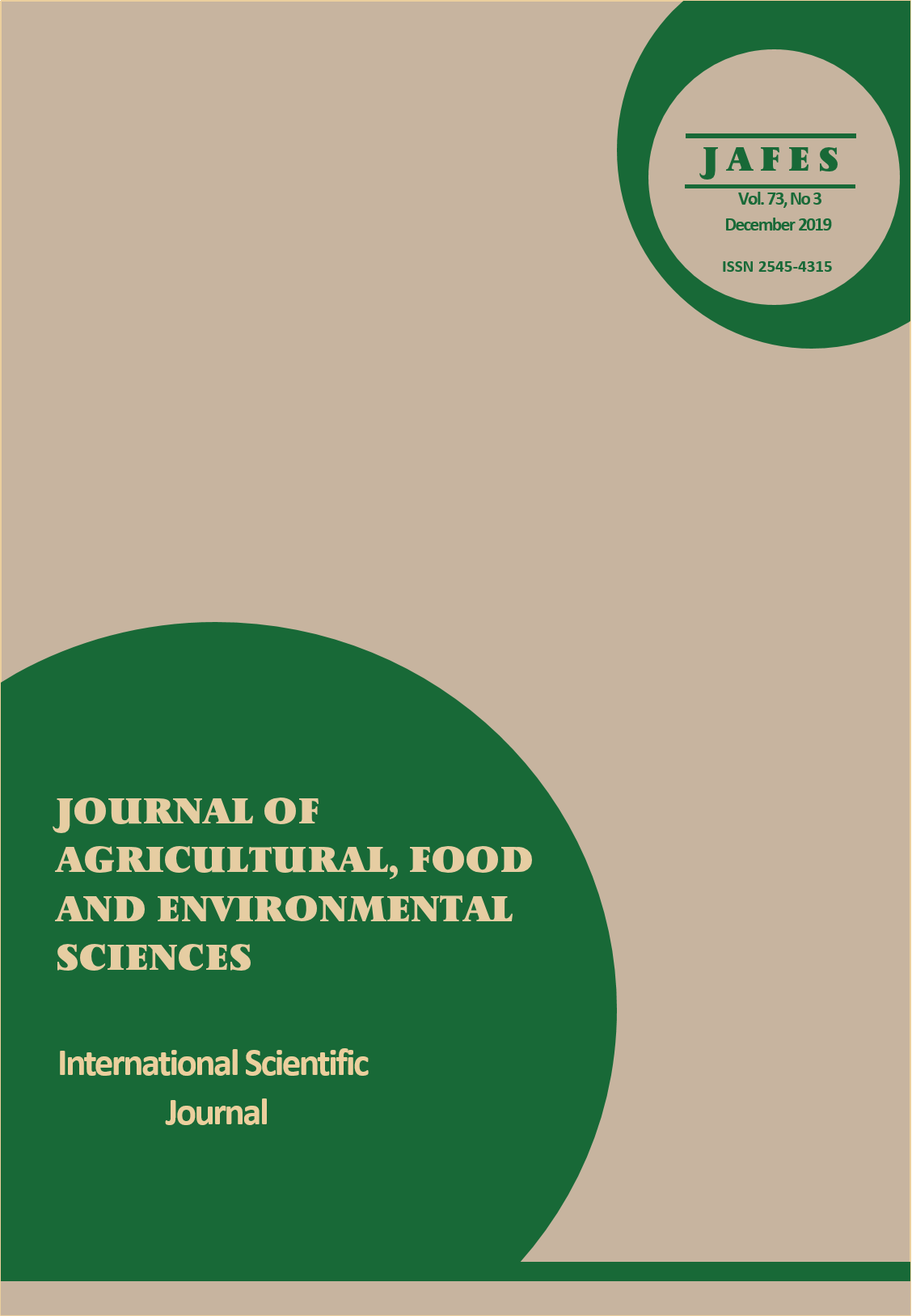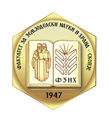DETERMINATION OF SOME PESTICIDE RESIDUES IN APPLE JUICE BY HIGH-PERFORMANCE LIQUID CHROMATOGRAPHY
Keywords:
RP-HPLC, SPE, method development, validation.Abstract
A new, simple and reliable reversed-phase high-performance liquid chromatography (RP-HPLC) method for determination of 2,4-D ((2,4-dichlorophenoxy)acetic acid), atrazine, malathion, fenitrothion and parathion residues in apple juices has been developed and validated. Successful separation and quantitative determination of analytes were performed on Purospher STAR RP-8e (30 x 4 mm, 3 μm) analytical column, with mobile phase consisted of acetonitrile/water (45/55, V/V), flow rate of 1 mL/min, constant column temperature at 25 oC and UV detection at 220 nm and 270 nm. A solid-phase extraction (SPE) was used for concentration and clean-up of analytes. Specificity, selectivity, linearity, precision, accuracy, limit of detection (LOD) and limit of quantification (LOQ) were tested for the method validation according to European Commission guidelines for pesticide residue analytical methods, and all performance characteristics were found within acceptance criteria. Calibration curves were linear within the range less than 50 % of the maximum residue limit (MRL) values and 20 % above for all investigated pesticides (R2 > 0.95). Under the stipulated conditions, values for relative standard deviations (RSD) of retention times and peak areas were 0.12 % - 0.28 % and 0.08 % - 8.50 %, respectively. The obtained values for recoveries ranged from 93.65 % - 118.62 %, with RSD ≤ 5.64 %. This method was successfully applied for determination of investigated pesticide residues in apple juice samples, which were taken from Macedonian markets. The run time of assay obtained from this chromatography condition was about 4 min.
References
Attallah, E. R., Barakat, D. A., Maatook, G. R. and Badawy, H. A. (2012). Validation of a quick and easy
(QuEChERS) method for the determination of pesticides residue in dried herbs. Journal of Food Agriculture
and Environment, 10 (1): 755-762.
Candrawinata, V. I., Golding, J. B., Roach, P. D. and Stathopoulos, C. E. (2015). Optimisation of the
phenolic content and antioxidant activity of apple pomace aqueous extracts, CyTA – Journal of Food, 13 (2):
–299.
Chua, X. G., Hub, X. Z. and Yaoa, H. Y. (2005). Determination of 266 pesticide residues in apple juice by
matrix solid-phase dispersion and gas chromatography-mass selective detection. Journal of Chromatography
A, 1063: 201–210.
Cunha, S. C., Fernandes, J. O. and Oliveira, M. B. P. P. (2009). Fast analysis of multiple pesticide residues in
apple juice using dispersive liquid–liquid microextraction and multidimensional gas chromatography–mass
spectrometry. Journal of Chromatography A, 1216 (51): 8835-8844.
Document No SANCO/12495/2011. (2011). Method validation and quality control procedures for pesticide
residues analysis in food and feed.
Dong, M. W. (2006). Modern HPLC for practicing scientists. John Wiley & Sons Inc. Hoboken. New Jersey.
European Commission. (2010). Guidance document on pesticide residue analytical methods. SANCO/825/00
rev. 8.1.
Hercegová, A. and Mőder, M. (2011). Determination of some selected pesticide residues in apple juice by
solid-phase microextraction coupled to gas chromatography – mass spectrometry. Acta
Universitatis Agriculturae et Silviculturae Mendelianae Brunensis, 59: 121-128.
Hyson, D. A. (2011). A Comprehensive Review of Apples and Apple Components and Their Relationship to
Human Health, Advances in Nutrition, 2: 408–420.
Jeannot, R., Sabik, H., Sauvard, E. and Genin, E. (2009). Application of liquid chromatography with mass
spectrometry combined with photodiode array detection and tandem mass spectrometry for monitoring
pesticides in surface waters. Journal of Chromatography A, 879 (1): 51-71.
Pang, G. F., Fan, C. L., Liu, Y. M., Cao, Y. Z., Zhang, J. J., Fu, B. L., Li, X. M., Li, Z. Y. and Wu, Y. P.
(2006). Multi-residue method for the determination of 450 pesticide residues in honey, fruit juice and wine
by double-cartridge solid-phase extraction/gas chromatography-mass spectrometry and liquid
chromatography-tandem mass spectrometry. Food Additives and Contaminants, 23 (8): 777-810.
Regulation (EC) No 396/2005 of the European Parliament and of the Council of 23 February 2005 on
maximum residue levels of pesticides in or on food and feed of plant and animal origin and amending
Council Directive 91/414/EEC Text with EEA relevance.
Sanchez-Ortega, A., Sampedro, M. C., Unceta, N., Goicolea, M. A. and Barrio, R. J. (2005). Solid-phase
microextraction coupled with high performance liquid chromatography using on-line diode-array and
electrochemical detection for the determination of fenitrothion and its main metabolites in environmental
water samples. Journal of Chromatography A, 1094: 70-76.
Tomlin, C. (11th ed.) (1997). The pesticide manual incorporating the agrochemicals handbook. British Crop
Protection Council, Royal Society of Chemistry Cambridge.
Topuz, S., Ozhan, G. and Alpertunga, B. (2005). Simultaneous determination of various pesticides in fruit
juices by HPLC-DAD. Food Control, 16: 87-92.
Tseng, S. H., Lin, Y. J., Lee, H. F., Su, S. C., Chou, S. S. and Hwang, D. F. (2007). A multiresidue method
for determination 136 pesticides and metabolites in fruit and vegetables: Application of macroporous
diatomaceous earth column. Journal of food and drug analysis, 15 (3): 316-324.
Velkoska-Markovska, L. and Petanovska-Ilievska, B. (2013). Optimization and development of SPE-HPLCDAD
method for the determination of atrazine, malathion, fenitrothion and parathion pesticide residues in
apple juice. Macedonian Journal of Chemistry and Chemical Engineering, 32 (2): 299-308.
Velkoska-Markovska, L., Petanovska-Ilievska, B. and Markovski, A. (2017 a). Application of rapid
resolution liquid chromatography to the analysis of some pesticide residues in apple juice. Agriculture and
Forestry, 63 (3): 207-219.
Velkoska-Markovska, L., Petanovska-Ilievska, B. and Markovski, A. (2017 b). Development and validation
of RP-HPLC method for determination of pesticide residues in apple juice. Book of proceedings, 3rd
IMEKOFOODS, Metrology Promoting Harmonization and Standardization in Food and Nutrition.
Zanella, R., Munaretto, J. S. and Martins, M. L. (2013). Determination of pesticide multiresidues in apple,
pear and grape using modified QuEChERS and analysis by LC-QTOF MS. Agilent technologies. Inc.



